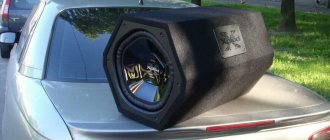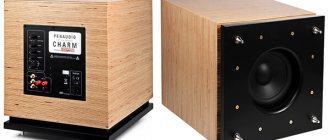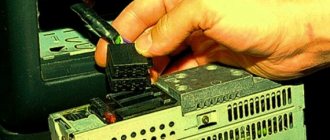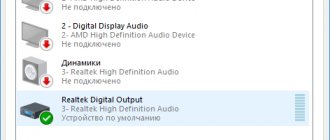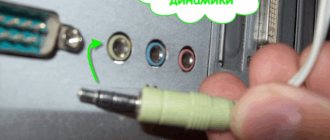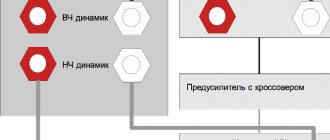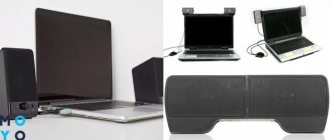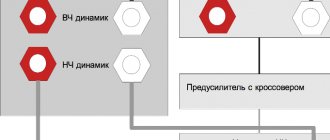The question of how to connect speakers to the radio is of concern to music lovers who have purchased a car with a good sound system. They want music to surround them everywhere, buying expensive audio players and headphones to experience high-quality sound. These devices are not always enough, and they gradually transfer the acoustics directly into the car, using the radio built into the car as a distribution device. The sound is reproduced by powerful devices specially calibrated for your favorite genre and format of music.
People find it difficult to figure out how to connect speakers to a car player. You will need to run wires to properly connect your home speakers to your car. You can connect several speakers using speakers from a music center and a special amplifier for these purposes.
Home amplifier from car
To use a car amplifier at home, we need a power supply and speakers (subwoofer optional).
I’ll warn you right away that the current consumption of some car amplifiers approaches the 40A ! This is a very high current. Therefore, not everyone will be able to find a suitable power supply for 12V and a current of 30 - 40 A :)
But to power the car amplifier, a computer power supply in AT and ATX format will do. Some models of computer power supplies can supply significant current via the +12V bus. Judging by the characteristics of the cheapest models that are now sold in stores, this is 12A. Top-end, expensive models give out 50 - 70A !
Such a block produces a current of 14A at the +12V output.
How to determine? We look at the characteristics of the power supply, the line “power along the 12V line”. We see, for example, 200 W. Divide 200 W by 12, we get the maximum current on the 12V bus
16 amps If the power supply is on hand, then look at the sticker on the case. All the block parameters are usually indicated there, including the maximum current for each bus.
All PC power supplies have yellow wires going to MOLEX and SATA connectors - this is +12V, and black wires are negative (common, GND ). I have already talked in more detail about using power supplies from a PC.
If you find a power supply with a lower current, for example, like I did with 12V ( 10A ), then you shouldn’t be upset. The amplifier simply will not be able to work to its full potential and will play quieter. Now about the connection.
There are 2 terminals on the body of the car amplifier for connecting power. The negative power supply is connected to the GND terminal, and the +12V terminal is connected to the positive power supply. As a result, the amplifier is in sleep mode ( Stand by ). To switch the amplifier from standby mode to operating mode, you need to apply +12V to the REM ( Remote - “control”). We throw a jumper from the +12V terminal to the REM . Then turn on the power supply.
As you know, car radios have a special output (usually blue). Most modern radios have it, and it is used to turn on active antennas, extend antennas and turn on external amplifiers and subwoofers. If you turn on the car radio, a voltage of +12V appears at this output. The load current of this output is small, about 100 – 120 mA.
By the way, when installing an amplifier in a car, it happens that the control (blue) wire is already connected, for example, to the same active antenna. What should I do? Then you can supply +12V voltage to the REM through a latching button, and place the button itself on the car panel. The same technique can be implemented at home. Just put a regular toggle switch or rocker switch in the gap in the +12V – – -> REM . These are sold at any auto supply store.
Attention! Since the current consumption of a car amplifier can reach 40 amperes or more, it should be connected to the power supply with copper wires with a cross-section of 6 - 10 mm 2. If possible, make the connecting wires shorter. This is ideal. In practice, if you do not “drive” the amplifier to maximum mode, ordinary wires with a cross-section of 1.5 - 2.5 mm 2 will do.
An ordinary MP3 player can be used as a sound source. You will also need a 3.5 mm adapter. Jake on "tulips".
When setting up the amplifier, do not forget that on its panel there is a control for the input signal level - “LEVEL”. This is nothing more than a volume control , like those found on analogue tape recorders or cassette players.
At a level of 0.2V, the maximum signal level is received at the input - the amplifier will operate louder. If you turn the variable resistor knob to 8V , then the minimum signal from the player will be received at the input. Naturally, the signal level can also be set using the volume control of the MP3 player itself.
On many amplifiers, the input level control only has a pointer in the form of a stylized arrow or pointer.
Depending on the configuration of the car amplifier, it can be used in different ways. The simplest example.
Most amplifiers have filter mode switches (crossovers). For example, on the CALCELL I found an X-OVER SELECTOR (other models may have a BASS/FLAT/TREBLE and similar ones). When selecting a mode, the corresponding filter is activated – LP (40Hz – 160Hz), HP (40Hz – 600Hz). OFF mode turns off all filters (aka FLAT ).
In FLAT , no signal correction occurs. Roughly speaking, what goes into the filter is what comes out.
If you select the LP mode, the input filters cut off all frequencies above 40 - 160 Hz and leave only low audio frequencies. This mode is suitable for working with a subwoofer.
The filter works on two of the 4 amplifier channels at once, for example, on the front speakers ( FRONT ). Two other amplifiers also have such switches - rear ( REAR ). The division of amplifiers into FRONT and REAR is conditional. If we examine the circuitry of the device in detail, it turns out that all four amplifiers in its composition are identical, like Siamese twins. But that's not the point.
see also
Comments 53
Hello, the discussion may already be closed, but I want to add. There is a Sven subwoofer system and 2 speakers, on the advice of VADIM-LCV, without soldering anything, after 4 diodes I soldered 2 wires and threw them on the battery. everything is loud. Tomorrow I will connect the subwoofer into the circuit: radio - speakers)))
A very pressing question, can you take a photo, it will be useful information for many
I already forgot when it was, but if you want, you can figure it out. That car is no longer there.
When I installed an amplifier and speakers from a home theater in my car, I just took a power supply from the computer, took out the battery and instead connected the on-board network and powered the amplifier with 220V, or you can buy an inverter and power it from it
after the trance there are 4 diodes. after them, connect 12 from the board and use it. If you connect to (diodes) the voltage will drop and will not work.
A reasonable question arises - how much power will you get? 5 watts no more. It’s easier to just buy a 220V converter and use the built-in amplifier. Otherwise there’s no point at all.
Well, if the amplifier power is 5 watts... then yes. the power will be 5 watts.
you are wrong. There are formulas for calculating the output power from the resistance of the acoustics and the supply voltage of the output stage (in this case, push-pull) P = (0.707U)2/Rн = U2/2Rн. even if we assume that the efficiency of the amplifier is 100% (and this does not happen ) unipolar + 12V power supply produces an output power of 4.5 watts for a load resistance of 4 ohms
I don't insist. I have it playing and boom. I have enough.
The “boom” in this case is more determined by the quality of the speakers themselves, for a machine 5 watts per channel (honest Soviet ones) is a steal. In this case, the imported watts will turn out to be around 45 watts per channel - the bourgeoisie indicate the power using the RMS method, it just needs to be divided by 10. Remember your subwoofers - 400 “their” watts is equal to 40 watts of ours. I used to organize discotheques, I remember what Soviet concert “crowns” were like, weighing more than 60 kg per speaker and with a power of around hundreds of watts also per speaker. Topicstarter's heads indicate 30 watts, the diffuser diameter is at best 4′ (10 cm), or even less. They will not produce 100% bass in the car. They may create a normal sound pressure in the vocal range, but these tricks are not enough for high-quality music reproduction. Or the car should be SOUNDproofed, not soundproofed.
do not know how. but I took a 2.1 buffer + 2 speakers system, threw out the trans, unsoldered the diodes, connected +12, connected it to the radio and listened to wonderful music just as loudly and with soft bass! no difference. and all your formulas for diameters, etc., etc. I carry it in the trunk. and the radio tape recorder sings with its own and the buffer with its own. what can I tell you... if you don’t want to live in peace, create a problem for yourself!
Yes, they sounded the same. Torn suspensions appear only at high volume levels and a large amount of bass in the music; at medium volumes there is practically no difference. In dynamics, the main holder of the diffuser is the centering ring located under the diffuser. ))
In general, the speakers are from the legendary ONKYO; today’s youth have never heard such a name. Threat from the car which.
I wonder how they sounded in their new guise)
In general, the speakers are from the legendary ONKYO; today’s youth have never heard such a name. Threat from the car which.
In general, the speakers are from the legendary ONKYO; today’s youth have never heard such a name. Threat from the car which.
Osaka Denki Onkyo was founded in Japan in 1946. Known as a manufacturer of vinyl record players, dynamic speakers, acoustic systems and other audio components. It produced reel-to-reel tape recorders and cassette decks under the Docorder brand. Also uses the Integra brand. It produced portable equipment for the US market under the CONION brand. Currently, they continue to produce equipment for home theaters.
In general, no good will come of these heads. throw it back like a regular sub, nothing more. Don’t turn the volume too high, these speakers won’t give you any bass, in addition, there will be SOI from the radio amplifier, which will be limited in voltage at the output stages
If you connect an 8 Ohm speaker to the output of a radio whose output is 2 ohms, then the output power of the radio will drop by a factor of 4 and nothing bad will happen
Yes, it’s already clear, you can see everything from the photo. The question is how to pull up 8 ohms to the low-impedance output of the radio
It’s easy - if the output of the radio is 2 ohms, then you need to connect 4 8-ohm speakers in parallel, and if you want big hemorrhoids, then wind up a matching output transformer
Always your K.O. ))) I meant in the current circumstances.
1) - you need to know what the output power of your car radio is and how much ohm it has an output and dance from there 2) in your housing office for a bubble they will make you a couple of decent boxes 3) make the box beautiful - no problem 4) buy a couple of auto-coaxials 5) connect to radio and enjoy decent sound
There were original speakers. The sound is simply FAIRY TALE... “O_o”... so I got confused with these speakers, temporarily of course. PHOTO ADDED!
Yes confirm. The sound from these honest old paper cones, especially in the mid and upper bass, was good. (I drove a Nexia at one time and was pleasantly surprised by the quality of the rear).
There are 4 diodes on the board after the trans which has a middle output from the secondary - this means the power supply is 2-polar
Car speakers can be purchased for a small price, stuffed into a couple of wooden boxes, covered with material for speakers and it will be practically, , firmA, , And you don’t need to engage in electronic masturbation - 4 cotton wool will not suit you
The fact that 30 watts is written on the column is very doubtful, there are at most 4 watts there at a stretch. 8 ohm - you can trust. Therefore, at high volumes of your radio, the speakers begin to choke from overload. It’s easier not to bother with bullshit and buy powerful coaxial car speakers.
so RMS is written, it is clear that 3 watts are Soviet. Yes, no options. If there was another pair of the same speakers, the midbass could be paralleled in pairs.
It will most likely not be possible to connect through a native amplifier - it has bipolar power supply.
In such garbage dumps there was no bipolar power supply in life.
Why then do 3 wires come out of the transformer?
From the trans to the secondary there are 2 identical windings connected in series and the middle terminal is grounded and the outer terminals go to diodes
Why the middle wire then at all, if everything is as you said? Bipolar power supply for the amplifier chip is necessary, as written below.
Why then do 3 wires come out of the transformer?
bipolar +-18 volts costs TDA, and by the way, car radios also often cost TDA, but they diligently erase the inscriptions with them
Why then do 3 wires come out of the transformer?
Oh, there are three, then oh. I was wrong. I didn’t look at the photo, it’s not very convenient to view it from a phone))
In such garbage dumps there was no bipolar power supply in life.
Very much so it was and is
